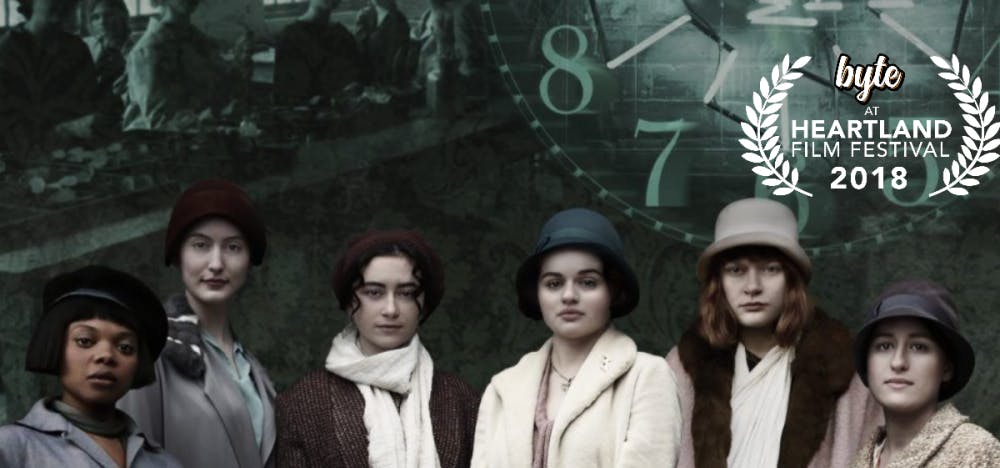by Tanner Kinney The most important thing I’ve learned while studying history is that there are so many great stories left untold in a modern age. There are so many great, culturally significant events that just get lost along the shuffle of time. Father Time doesn’t care about who you are or the things you’ve done, it comes down to society to remember who you are. There are many great people who never get their stories told. Fortunately for the radium girls of the late 1920’s, directors Lydia Dean Pilcher and Ginny Mohler have created a phenomenal film depicting the long untold tale of young laborers fighting against the system in ways that (almost) changed the world. Radium Girls is a narrative based on true historical events. The story follows the fictional characters of Bessie and Josephine, sisters who are glow-in-the-dark watch dial painters for American Radium. They have both bought into the magic of corporate America during the roaring 20’s, with Bessie dreaming of being an actress in a motion picture and having crowds of adoring fans. However, when Josephine becomes ill, the sisters uncover the truth about radium: it’s a deadly poison. With Jo’s life and body now on a timer, Bessie becomes determined to bring the horrors of radium poisoning to light and take down American Radium. The most interesting part of this filmmaking is that it borders on documentary-style. Intercut during transitions during parts of the film are either Josephine thinking about the past, or footage that’s either from the time-period or was altered to look as close to it as possible. The film is in no way a documentary, and doesn’t market itself as such, but these moments give the narrative more legitimacy for an audience member who might not know the story. Radium Girls is constantly grounding the audience in the world it creates, and that makes the narrative all the more impactful because of it. Which leads into the narrative and writing itself, which is phenomenal. The characters are all written realistically, and are supplied with little bits of humor to provide relief from such a dour situation. During the Q&A after my screening of the film, an audience member expressed concern that the film wasn’t nearly dark enough to match the horrors of the story it was telling, but I don’t believe that to be the case. There were already plenty of grotesque moments and descriptions within the film; any more and I feel it may have started to hurt the film in terms of myself and, at least I’d imagine, most general audiences. This isn’t a story about the sheer terror of radium poisoning, this is a story of Bessie trying to change her small part of the world and save her friends. It was touching and heartfelt, with a feel-good ending that is intentionally soured before the credits start to roll. Bringing the great narrative to life are a batch of great performances from every lead within the film. Special props deserve to be given to Joey King’s portrayal of Bessie, as there was a noticeable physical and emotional evolution to the character that you don’t typically see in a lot of films. King performs spectacularly as the leading lady, making you truly believe this is the girl who inspired a revolution (of sorts). All of this makes it more surprising to discover that King was not only the lead in the so-bad-it’s-good Wish Upon, along with being a plot critical character in the critically panned Slender Man. She’s clearly a fantastic actress with the right script, and I sincerely hope she starts picking better projects to so she can truly shine. Other great performances come from Abby Quinn’s Josephine, playing the caring older sister who’s quite literally falling apart perfectly. There’s great chemistry between Quinn and King, with both playing off of each other (whether its comically or emotionally) excellently. Susan Heyward also does great in her role as a no-nonsense reporter, easily being the most likeable of the side-characters within the film. The only weak spot would come from one of the other major side-characters, Walt (played by Collin Kelly-Sordelet), who doesn’t exactly have the best line reads. They’re serviceable, but compared to the star power around him it’s definitely more noticeable how average his performance. The soundtrack should also be noted for how lovely and period accurate it is. I’m a sucker for that sound and aesthetic, and this film played me like a fiddle (or, rather, maybe a jazzy saxophone). Costuming and set-design also played into this perfectly. Returning to the point about it feeling like a documentary, it really did feel like a story pulled straight from the 1920’s. Bessie may have ended the film not wanting to be in motion pictures anymore, but Radium Girls is one that’s worth the nickel.



















